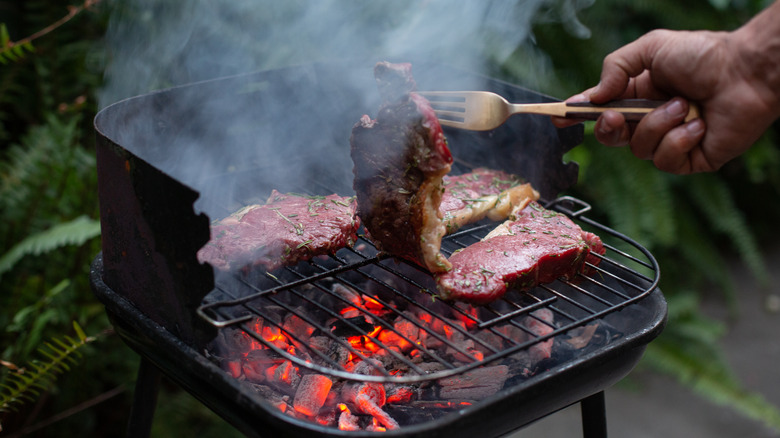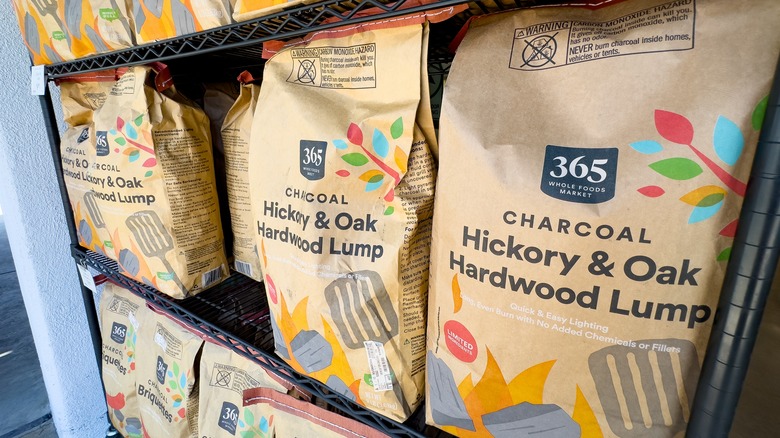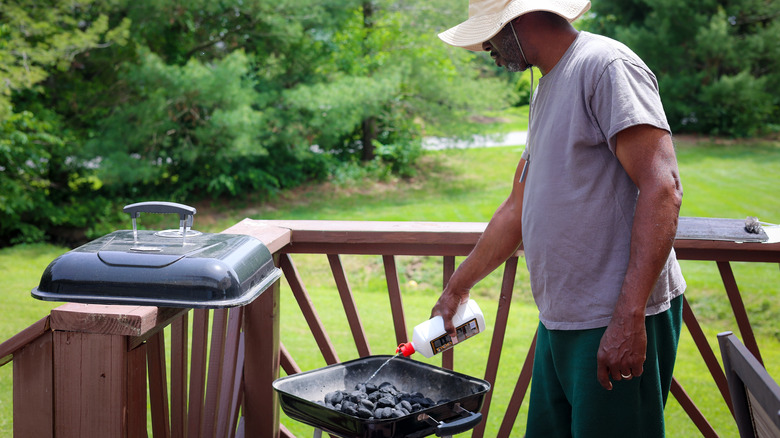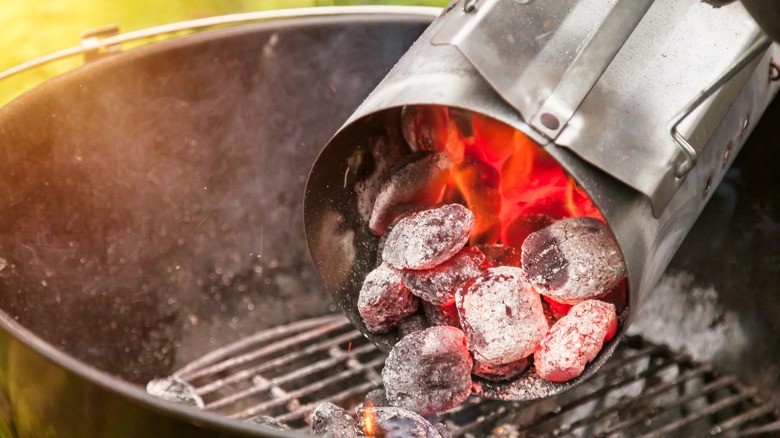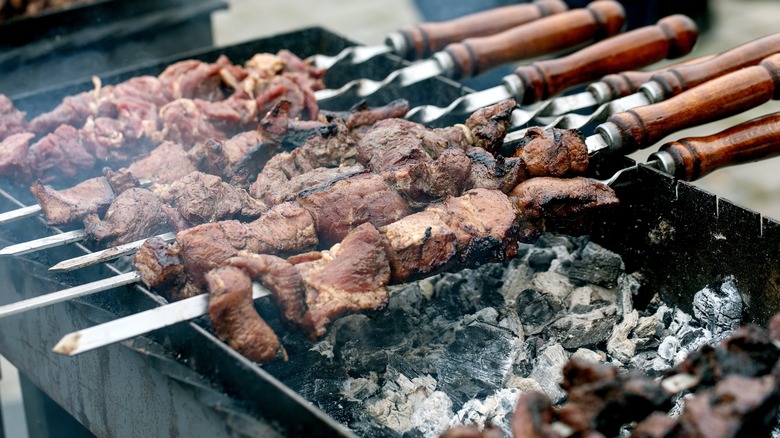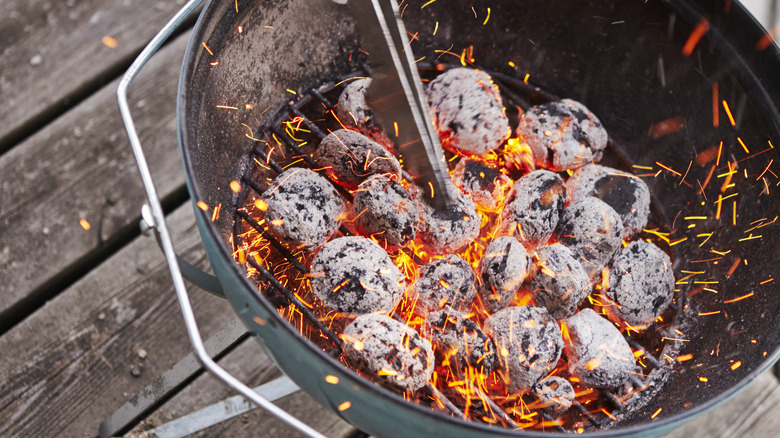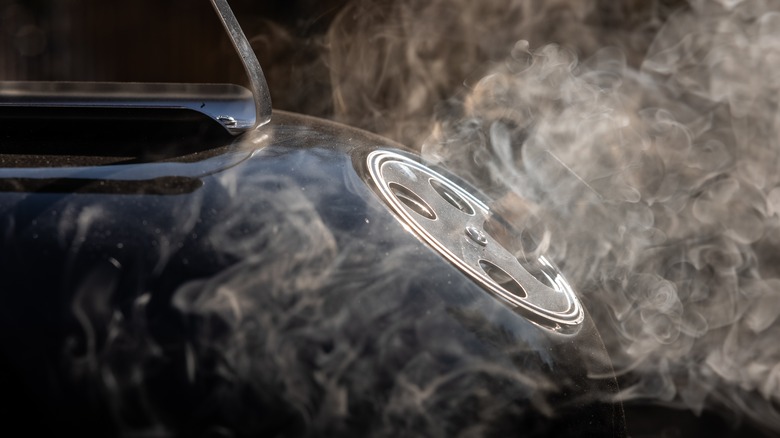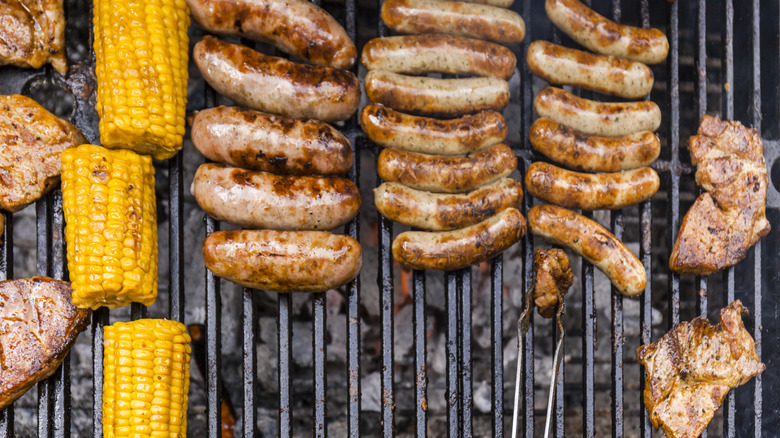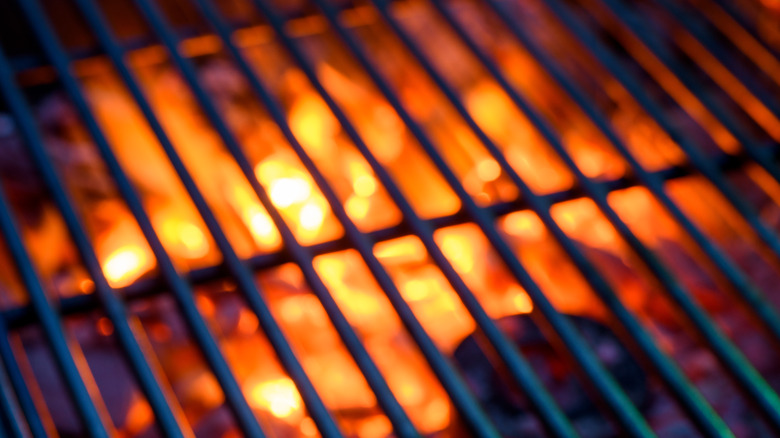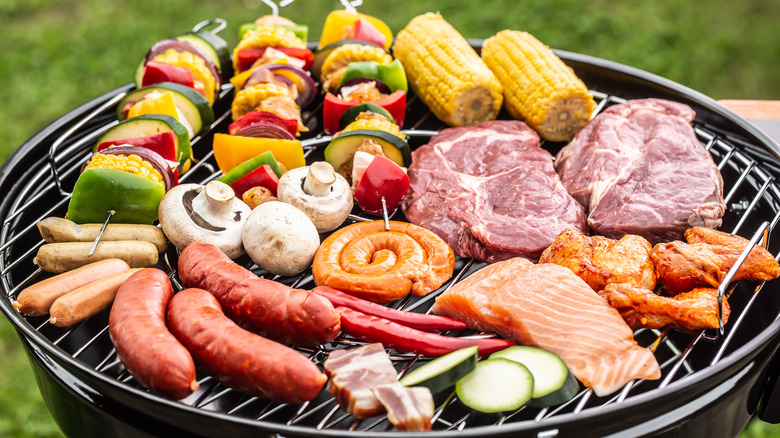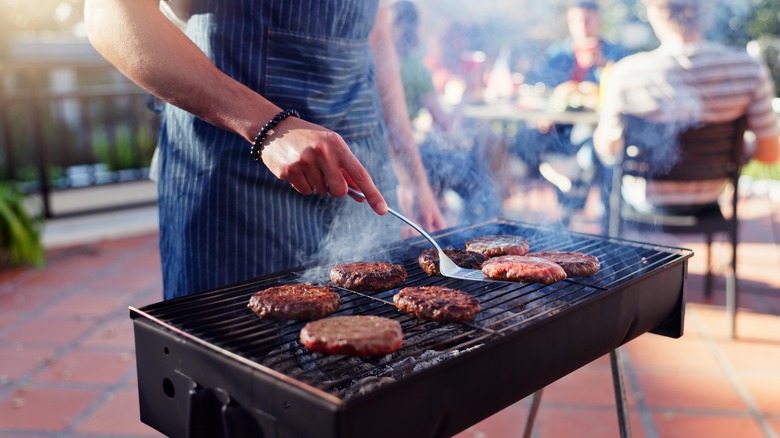11 Mistakes People Make With Charcoal Grills, According To Pitmasters
For many, firing up the grill is synonymous with good weather, social gatherings, and mouthwatering food. Whether it's a simple backyard barbecue, preparing a wiener on a camping trip, or tailgating, grilling can turn any location into a pop-up kitchen.
Many swear by the convenience and temperature control of electric and propane grills; others enjoy the hands-on approach of cooking over glowing coals. From lighting and tending the fire to the manual control of coal placement, charcoal grilling offers the kind of versatility its electric and propane counterparts just can't match. It also delivers deep, smoky flavors in a way that other types of grills can't replicate.
While charcoal grills deliver unbeatable flavor, they aren't as easy to master as electric and propane grills. Unlike gas or electric models with push-button ignition and precise temperature control (things that make some believe grilling is the easiest type of cooking), charcoal grills require a lighting strategy, manual temperature adjustments, and a fair bit of patience. To help you navigate these challenges during your next cookout, we have asked three charcoal grill experts to share their insights about the most common charcoal grilling mistakes: Scott Thomas, the founder of Grillin' Fools (a website that offers step-by-step, pic-by-pic grilling instructions), Dustin Green, Head Grill Master at Weber, and Erica Blaire Roby, award-winning pitmaster, Food Network "Master of Cue," and the founder of Blue Smoke Blaire's BBQ.
Failing to distinguish between different types of charcoal
There are two main types of charcoal used in backyard grilling — natural lump charcoal and briquettes. Lump charcoal is made from carbonized hardwood and is typically considered the more natural of the two. Briquettes are made from compressed ingredients like coal dust and sawdust, plus fillers such as starch and borax. While this makes briquettes more convenient than lump charcoal because they allow more temperature control and longer grilling, many people don't like the fact that they contain additives.
Scott Thomas believes that charcoal choice is important. To drive the point home, Thomas told us about a grilling class that went sideways after the wrong charcoal choice. "A few years ago, a local grocery store chain asked me to teach a grilling class inside their cooking school," he said. Thomas noted that the store used its own charcoal that smelled like chemicals, and he could really "smell the difference."
Using lighter fluid to start the fire
Many inexperienced backyard grillers may view using lighter fluid to ignite the coals as a stroke of genius. After all, dousing the coals with a flammable fluid seems like a fast and convenient way of getting the grill ready for action. However, this method has some serious downsides. Aside from creating a fire hazard, lighter fluid is likely to infuse your tender pork chops, sausages, and vegetables with an unpleasant chemical taste.
Scott Thomas points out that, similar to starting a fire using briquettes that contain artificial binders, using lighter fluid to get a grill going is a bad idea. That said, Thomas admits he used to douse his barbecue with lighter fluid once a year for the annual pig roast. "To grill the pig, I needed 100 pounds of hot charcoal. It's really hard to get that much charcoal hot quickly, so I would use lighter fluid to get it started and then let it burn for an hour to make sure the chemicals were burned off before bringing my protein anywhere near those chemicals," he explains. But he revealed that there's an even better option than lighter fluid for your fast-burning needs: the weed torch.
Skipping the chimney starter to light the coals
For the uninformed, a chimney starter is a metal cylinder designed to light charcoal quickly and evenly — no lighter fluid necessary. The device features a small rack at the bottom for pieces of highly flammable materials like crumpled newspaper. Once ignited, the device channels the heat to fuel the charcoal. Now, all you need to do is wait until the coal is fully lit before placing it inside the grill — this typically takes between 15 and 20 minutes.
Dustin Green says that many people don't use chimney starters simply because they are unaware of their existence. "Once they see one in action and use it for the first time, they rarely go back," he says. "[Chimney starters] simplify the process, improve consistency, and give you greater control. Think of them as a built-in timer and heat management system." Though there is smoke at first, Green noted that when the coals are glowing and change color, you can begin cooking.
Not waiting for the coals to ash over
As tempting as it may be to throw a steak on the grill as soon as the coals have caught fire, this impatience usually comes with consequences. Grilling before the coals reach their optimal cooking temperature can lead to unevenly cooked food. This is because coals that are still partially black produce inconsistent heat, making it difficult to tell when your food is done. As a rule of thumb, smoke is a sure sign that your grill isn't ready for cooking because the coals are still burning off moisture and binders.
According to Dustin Green, waiting for the coals to turn white or gray before cooking is one of the most important parts of charcoal grilling. "If the charcoal is not prepared correctly, it doesn't matter how well-seasoned your food is — you will taste a harsh, bitter, raw charcoal flavor that will overpower the authentic, delicious grilled tastes we are looking for." Scott Thomas agrees, adding that waiting for the coals to ash over is often linked to using briquettes as a fuel source. "It's the hope that the chemicals have all burned off. Usually they haven't unless the fire has almost died off," he explains.
Running out of charcoal or using too much fuel
Successful grilling isn't just about fuel type and heat control, but also about stocking up on enough charcoal to maintain a steady temperature throughout the cookout. Erica Blaire Roby believes that charcoal control is the key to successful grilling. "If too much charcoal is used then the food can be burned or dried out. If too little is used, then the heat may die out before the food is cooked properly," she says. Either way, the cook — and the diners — end up disappointed.
Scott Thomas echoes this sentiment, saying that too much charcoal can make the fire overly hot and too little won't complete the job. This means that more charcoal will have to be added to the barbecue, which can be difficult once the cooking process is underway — particularly because most grills don't have a dedicated access door for refueling charcoal mid-cook. "That means removing the protein (that is usually hot and greasy), removing the grill grate, which is even hotter and also greasy, adding charcoal and putting all that back in the grill," Thomas says. "Almost every pitmaster has a story about lifting the grill grate out, protein still on top only to have the meat roll off and onto the ground and that's when they learned to remove the protein first. And they learned it the really hard way."
Ignoring the grill's vent control
Most quality charcoal grills offer vent control, a system for managing airflow and heat inside the unit. Vent positioning — from fully open to nearly shut — impacts how the coal maintains temperature during grilling. Dustin Green explains that charcoal needs oxygen to burn, and managing this airflow is how pitmasters control the cooking temperature. He noted that for some types of charcoal grills, "The top damper works like a vacuum. It pulls the air from the bottom of the grill and allows it to circulate throughout the grill before exhausting through the top damper."
According to Scott Thomas, typically higher-quality grills feature better seals on their vent controls. However, no matter what grill you invest in, understanding how it works means learning its vent system because every model is different. Each adjustment to a vent can shift the grill's internal temperature, allowing for both low-heat smoking and high-heat searing.
Failing to create different heat zones
Most casual grillers spread the coal evenly across the entire cooking surface of a grill, not realizing that this can easily lead to burnt interiors and undercooked interiors. Erica Blaire Roby says that setting up different heat zones on a charcoal grill is crucial to controlling how the food cooks. "Learning the difference between direct and indirect heat helps prevent burning the outside of your meat while the inside cooks. A reliable method is to start searing your beef over direct heat, then move it to indirect heat to finish cooking gently and evenly. This combo gives you better control and more delicious results," she says.
According to Scott Thomas, two-zone grilling can turn any charcoal grill into a smoker that cooks low and slow at temperatures between 200 F and 250 F. He explains that this is a great strategy for grilling tough cuts of beef without burning the outside of the meat and drying out its interior. "Hot coals on one side of the grill. The meat goes on the other side of the grill. The cool side. So the meat cooks indirectly and does not burn, allowing the connective tissue to break down and the fat to render to make for tender, juicy meat with an outstanding flavor bark," he instructs.
Failing to preheat the grill grates
Just as you wouldn't slap a prime cut of steak on a cold skillet, grilling on unheated grates can lead to all sorts of problems. Even if the coals have already ashed over and are producing radiant heat, the grates need enough time to soak it up before being lined with food. And it's not just a matter of impressing your friends with perfectly symmetrical grill marks — not preheating the grates may just ruin your food altogether, as highlighted by Erica Blaire Roby. "The food will stick to the grates and tear when moved. Nothing ruins a beautiful dish than being left behind on the grates," she says.
Scott Thomas warns that while unheated grates don't make much difference when cooking low and slow, failing to get the surface of the grill hot enough for direct grilling is a recipe for disaster. "When cooking hot and fast (think steak and burgers), the meat will be done long before you get that wonderful browning," Thomas says.
Putting too much food on the grill
It can be tempting to load the grill with burger patties, chicken wings, veggies, and other items, particularly when cooking for large groups. After all, feeding a hungry crowd typically involves cooking large volumes and a variety of different foods. However, overcrowding the grill can have significant drawbacks you probably want to avoid during the next cookout, as Erica Blaire Roby explains. "When you put too much food on a charcoal grill at once, it can lead to uneven cooking and flare-ups, since overcrowding restricts airflow and heat distribution," she says.
Luckily, Blaire Roby reports there are very simple steps any home pitmaster can take to prevent this very common problem. "To avoid this, give each piece of food enough space to cook evenly. If you're grilling for a crowd, cook in batches to ensure everything turns out just right," she says. Ideally, leave around an inch or 2 between each steak, patty, or veggie you are preparing. This ensures that the heat flows freely around each item, promoting uniform cooking.
Grilling to time, not temperature
Gauging the doneness of food by time, rather than its internal temperature, is a sure way to over- or under-grill your meal. Scott Thomas says the biggest mistake he sees barbecue enthusiasts make over and over again is timing their cook instead of measuring the heat. To illustrate this, he points out that a grill job that takes him 10 hours could take someone else eight hours, and yet another person 12 hours, depending on the temperature of the grill. "I get asked more than any other question, 'How long did that take to cook?' This is the most useless question there is. The only answer is, 'It's done when it's done.' The size of the protein, fat content of said protein, heat of the fire, and weather conditions all can vastly change the timing," he explains.
To prevent any mishaps — and minimize stress — Thomas recommends grilling food ahead of time. According to him, early preparation doesn't affect the quality of the meat, provided that you wrap it in foil and a towel and drop it into an empty cooler (something he calls faux Cambro). "I used to stress about having the turkey done on time for Thanksgiving dinner every year. Now, I get my turkey done hours ahead of time and leave it an actual Cambro I invested in a few years ago," he says. "I don't stress [about] the turkey at all anymore. So basically, get a ballpark figure of when it will be done, start about three hours early and have that meat rest in some sort of Cambro until dinner."
Not cleaning the grill properly
Just as you would clean your pots and pans between meals, regularly cleaning the grill can go a long way to preventing grease buildup on the grates, and all the nasty smoke and odors that go along with burnt-on residue. Dustin Green says that "a clean grill is a happy grill," adding, "It will burn a bit hotter than a dirty one and will be more fuel efficient. Additionally, if a grill is not regularly cleaned, 'off flavors' can be transferred to your food."
Green recommends deep cleaning the grill on a regular basis and, at the bare minimum, scraping the grates with a brush before each use. His step-by-step approach begins with dumping the lit charcoal from a chimney starter into the grill, placing the grate on top, and covering the grill with the lid. Make sure that the grill vents are fully open and leave the grill to heat for 10 to 15 minutes. Once hot, a grill brush can be used to remove any leftover residue from previous cooking sessions. For a deep clean, Green advises working from the top to bottom. "I start with the cooking grates — removing and thoroughly cleaning them. I then move onto the cookbox, scraping out any built up grease or debris," he says.
Scott Thomas agrees that the grill cleaning process is all about heat and a quality grill brush. "I realize grill brushes get a lot of flack for the whole, 'but someone got a metal tine in their throat that came off the brush and somehow got stuck in the meat and they ate it.' I've been all over the country to the biggest BBQ contests in the world. I've never met someone or even heard of someone that this has happened to," he says.
